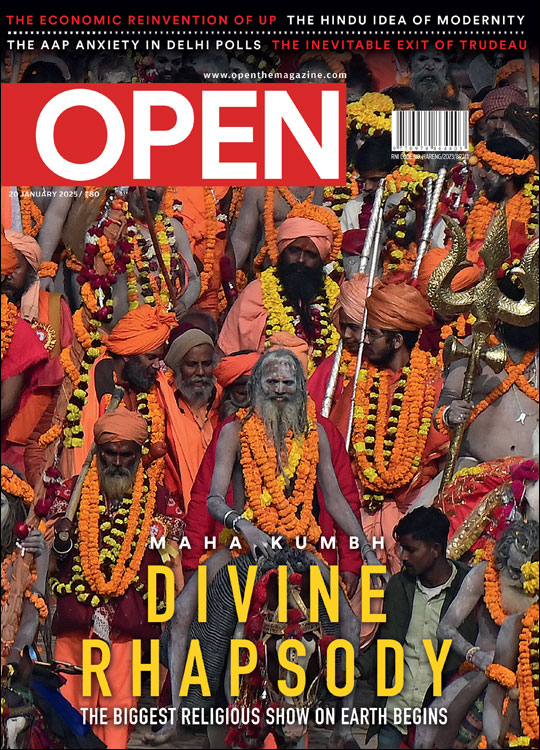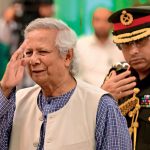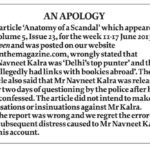Lord of the jungle and the magic potion
Once a bank officer, the determined herbal king of Kondagaon shakes money from trees in the Maoist strongholds of Bastar through a collective of 20,000 Tribals whose business looks to expand worldwide. The man and his empire
 Rajni George
Rajni George
 Rajni George
Rajni George
 |
23 Jul, 2014
|
23 Jul, 2014
/wp-content/uploads/2015/11/Profile-Lord-Jungle-main.jpg)
Once a bank officer, the determined herbal king of Kondagaon shakes money from trees in the Maoist strongholds of Bastar through a collective of 20,000 Tribals whose business looks to expand worldwide. The man and his empire
Jadi booti: literally, roots and plants, the extracts from the roots of plants and shrubs generally defined as herbs, popularly ascribed to India’s many-limbed kingdoms of green
Mythologised, problematised, proselytised, traditional herbs are a national (and international) obsession and a huge industry worth around Rs 9,000 crore, according to National Medicinal Plant Board of India estimates. From the verdant, Naxal- ridden district of Bastar in Chhattisgarh where Bastar champagne (a rare beverage made from the sulfi tree) and tasty fruits called kurlu are found, a much-publicised local form of Viagra (a rare indigenous variety of safed musli) has made a name for itself—through a man who has been translating the bounties of the jungle for more than a decade.
“They call me ‘The Father of Safed Musli’,” says 50-year-old Rajaram Tripathi, a strapping figure in kurta and jeans, pale and Brahminical-looking in publicity shots from a couple of decades ago, now tanned and very much a son of the soil. “It combats diabetes, and rejuvenates your entire system, reverses metabolism. People will slowly say, after you eat it for three or four months, that your wrinkles have lifted.” Big talk? Local Tribals are said to have lived longer and better on traditional health practices, using the abundant herbs and roots at their disposal to stay vital and virile.
“I felt like Alice in Wonderland,” Tripathi says of his first experience with the jungle’s potent flora, when we meet him on one of his 10 farms. We walk through long, vertiginous rows of trees in his ethno-medico forest, stopping to pluck some sarpagandha (Rauvolfia serpentina, used to create blood pressure drugs) off the plant; look at a velvety- leaved plant which cures stomach problems; identify annatto (Bixa orellena), richest source of vitamin E. He rattles off Latin names like they are actresses’ names or stock market darlings.
Tripathi, a bank worker turned agricultural entrepreneur and Bastar boy born and raised, has turned a cottage industry with one farm into a 10 acre, Rs 40-crore-a-year (Rs 10 crore domestic) herbal empire in Kondagaon district: the aptly named Maa Danteshwari Herbal Products (MDHP), extending as far as Ethiopia, Gulf countries and the Netherlands. (The Tribal nature goddess Danteshwari is worshipped in the area.) Functioning as a collective, MDHP employs 300 Tribal families and works with around 22,000 farmers over 1,000 acres.
It all began with a rare variety of safed musli (Chlorophytum borivilianum), a herb with lanceolate leaves found in natural forests from east Assam to Gujarat and abundant here, its roots used medicinally as a source of virility (through the saponins and alkaloids they contain), setting him on a path of 17 years of “organic herbal medicinal and aromatic farming”.
“The biodiversity of this place is so great, endangered species thrive here. There are 60 varieties of safed musli, of which one endangered species grows here [MDB-13 and 14]. I only work with this one,” says the entrepreneur, who has taken bare land back into the folds of the jungle. “I got organic certification from Germany, and Japanese agriculture [authorities] gave me certification that Ecocert [an inspection and certification body established in France in 1991] was not providing at that time.” The products rely on natural pest controls like neem and spiders, and feature ‘gold’ varieties.
Winning the Royal Bank of Scotland Earth Hero Award in 2012 and various national prizes such as the Desh Seva Ratna Award, Tripathi has been honoured by former President Abdul Kalam and has met the BJP’s LK Advani and Rajnath Singh, his self-devised PR package proclaims. Trained in natural ingredients in Rotterdam and invited to speak at nature expos in Dubai, participating in herbal trade conferences everywhere from Jhansi to Japan, this single-minded businessman farmer is constantly at work.
Officials and local media in Chhattisgarh’s capital Raipur applaud Tripathi’s industry not just on its own merit, but because it offers an option to Tribals trapped in India’s so-called ‘red corridor’, even if they are critical of his PR. For, not much has changed in the way of infrastructure for Tribals in the last decade or so; rampant Naxalite guerilla warfare gathers many of the disaffected into its grip, seeking control of their lands.
“Bastar has historically been an under- served area in terms of health services. Kondagaon district contains some of the most remote and forested areas in the district,” says Sulakshana Nandi, a healthcare worker of the Jan Swasthya Abhiyan, the Indian circle of the People’s Health Movement (a worldwide movement for health and equitable development), who has worked for 12 years in this area. “People are poor and are rapidly losing control of natural resources like forests that they have depended upon for generations. This exacerbates the poor status of health in that area.” Tripathi’s effort is one of the few to bring Tribals together in a sustainable collective asserting their connection to the land.
“Naxalites are the excuse for much that doesn’t happen in Bastar,” he says, speaking to media coverage around violence in this region of about 10,000 sq km. ‘This is the only sustainable solution for Bastar and other [similar] regions,’ he says in his mission statement. It cites the 6,000 to 7,000 Indian medicinal plants used in Ayurveda, Siddha, Unani and Homoeopathy practices; about 960 species in trade, 178 of them annually consumed in excess of 100 tonnes for an output of about Rs 10,000 crore, exports being upwards of Rs 1,000 crore. (World figures are projected to reach trillions by 2050). Of course, violence is reported daily and there are unexploded bombs people fear discovering, but this doesn’t mean people shouldn’t visit this beautiful part of the world, he opines, hinting at a resort in the works.
Water flows through Raipur’s plush airport under plexiglass panels, and through Chhattisgarh’s rural lands in the monsoon. Creosote puddles of water, sopping soil, rainbows just out of reach: here is the Bastar of villages, providing produce and profit. Yet it is ‘Jindal’s army’, the local nickname for the metal men who decorate the airport, that presides over ‘Credible Chhattisgarh’, the steel state’s hilarious take on the ‘Incredible India’ campaign. Development is paramount in this 14-year-old state (carved out of Madhya Pradesh) that produces more than 15 per cent of India’s steel and has been setting new benchmarks for rapid development; Tripathi and herbal entrepreneurs like him compete with a variety of concerns as they vie for governmental attention.
Raipur, an aspirational second-tier city of around 200 sq km steadily pumped with the steel wealth that passes through, is the kind of place where you want to read the T-shirt: ‘When Money Talks You Don’t Listen To Its Accent’, as one local’s says. The city plays a doctored version of the national anthem before movie screenings, featuring local politicians, which everyone stands for. Its local restaurants, often christened ‘Madrasi’, compete with the usual low-cost fast food outlets, and it has eight frequently- visited malls. A new Hyatt on a promotional rate of Rs 3,000 a room per night has been sold out for two weeks, its management tells us. The state’s roads are neat and traversed in an orderly manner, still smoothly paved as they head into nearby Bhilai, the steel industry hub, or scenic rural parts. Naya Raipur, or New Raipur, lies 17 km away, about 8,000 hectares spread out over 41 villages, planned to house 450,000 residents; India’s fourth planned capital city (after Gujarat’s Gandhinagar, Punjab’s Chandigarh and Odisha’s Bhubaneshwar) with a Rs 2,000 crore budget, according to reports.
“Sab chahiye [I want everything],” says our driver, who once drove a lorry, now drives a car, and will soon drive a bus, he vows. Second-tier city India is always looking in all directions, as are its architects. Land is the big challenge for them and for Tripathi: he needs more to fully capitalise on expanding demand. So do the state’sTribals, who try to keep pace.
One of seven brothers, Tripathi and his extended family, 40 or so of them, are all farmers. He was a State Bank of India (SBI) probationary officer in 1989, a college professor in the past, he says. “I had lots of jobs. After three years, a promotion was waiting for me at SBI. I was a good officer, there were good career prospects. People said, ‘People are committing suicide in agriculture and you are joining?’ But when I was at the bank, I saw the economic viability of krishi (agriculture). If you take the price of land, you have to classify this as expenses. And if there is debit, there is credit.” He chose the Grameen Bank model and studied 17 conventional crops, showing the results to National Bank for Agriculture and Rural Development (NABARD). Loans resulted, and steady if slow growth.
Every year, 20 million tonnes of produce is stored in various storage sheds on Tripathi’s 10 farms; his processing unit is 100,000 sq ft. Agriculture Information, an online and print agrarian resource, mentions Tripathi’s work with varieties of lemon grass (MDL-14) and stevia (MDS- 13 and 14) as well, and boasts of Tripathi’s tie-ups with multinational companies. His Ethiopia project is in its first phase: 14,000 acres for high-value herbal farming, with the Lootah group of companies. Tie-ups with American and European companies are in the works, he says. A guestbook is signed by visitors from the US, Japan and other countries, not to mention countless visitors from all over India, usually in large groups; the company provides consultancy services to corporate entities that want to develop high value herbal farms. A tissue culture lab continues his experimental laboratory work; species like Guggul (Commifora wightii) and Vacha (Acorus calamus) were commercialised here.
“There were 15 years of mistakes,” says Tripathi, who was born in Kaknar, Jagdalpur, to a family which suffered the misfortunes farmers are vulnerable to. “Tribals have one guru with 20 students; I had 20 gurus.” Abundantly educated— he has earned a BSc and an LLB in corporate law, MAs in Economics, Hindi and History, an Ayurved Ratna from Allahabad, an Ayurved Bhishgacharya from the World Academy of Ayurved (WAA)—he seems endlessly ambitious. His small bedroom, in a humble yet relatively affluent home decorated with Bastar’s ubiquitous wrought iron work, is lined with books. “Those books I have read,” he says, pointing to shelves of academic- looking botanical books in Hindi, “and those I am going to read”—another section of faded covers.
“He was top in everything,” says wife Shipra, who had a “love cum arranged” marriage with the man she met at university. A Tribal of the Kamar community (Gonds are also populous here), she doesn’t call her husband by name, like many here, though her children are studying in Raipur and they have some of the trappings of modernity: computer, phone, rough terrain car. Tripathi is saved as ‘Father ji’ on her phone. Part of MDHP’s management, Shipra is secretary of Samagra Adivasi Medicinal Plant Development Association (SAMPDA), a green NGO Tripathi founded ‘for total herbal revolution’, and involved with local women’s groups. Except for her features, her Tribal identity seems vestigial, like with many here; only older women go without sari blouses and bear tattoos.
Tripathi has raised several other commanders in his green army. He says he employs five experts who have studied medicinal plants at the doctorate level or are biotech engineers, 14 marketing experts and 10 managers. When more manpower is needed, all members pitch in to make up a workforce of around 1,000 people. “We don’t have a fixed salary,” he explains. “We distribute weekly or monthly honorariums to all our team members, including me, as per our work and responsibilities; from Rs 6,000 to 10,000 monthly. ‘Employees’ is not a suitable word. We say ‘associate tribal families’; 1,500 people are getting their livelihood from this farming.”
Dasmati Netam, from Keyoti 10 km away, leads a production team; an ambitious 36-year-old woman, she is head of MDHP’s All Tribal Women groups and President of SAMPDA. Unlike the other Tribals, known for their reticence, she has studied outside the state and speaks up often about her work, taking us home for rice wine. As the apparent leader of her village, she exudes confidence. “I’d like to go outside again,” she says, already seeming to have left its crude wooden fences behind.
What is Tripathi’s biggest challenge, aside from the need for more land? “Marketing. In India, until Amitabh Bachchan or Aamir Khan eats these things, people don’t.” Indeed, his main marketing platform is Central Herbal Agro Marketing Federation of India (CHAMF-INDIA); a far cry from Organic India domain. “And the next step is backward linkage,” he continues. “Our fight is with middlemen. Now we have negotiation power—ashwamgandha , for example, no one will sell less than 100 kg. If they do, we will blacklist them. We have to control the market. If everyone grows safed musli, who will buy it?”
Tripathi is set to launch ‘certified organic food supplements’ in select towns of Chhattisgarh before taking these to other parts of India. He projects sales of Rs 6 crore for these ‘value-added’ products. His teas and powders may look a little too rustic for the urbane consumer, but they are tasty and seem to find takers among the believers they are aimed at; the sales figure may well be realised.
With success, however, has come criticism. MDHP’s annual growth rate may be upwards of 14 per cent, but there are rumours of loans that were defaulted on, say sources in Chhattisgarh who feel he is encroaching on ‘jungle wala zameen’ (forest land); Tripathi refutes this, saying he paid the loan off two months ago. Tribals who have farmed for many years can get patta (legal registration papers), but he is not one, say others. Yet, Tribals may have found their most viable leader in the bank worker who put his hands to work on the land of his birth.
In his mission statement, Tripathi offers 10 acres for a pilot conservation project across neighbouring states. Will the rumble spread through his jungle? Time may prove harsh, but for now he is effusive. During our walk, he spots a long- tailed bird and we crouch till it takes off, feathers streaming. He asks us to close our eyes for two minutes, and while the gesture is stagey, the sound of green is unadulterated. “Take two deep breaths,” he says, beaming.

/wp-content/uploads/2025/01/Cover_Kumbh.jpg)











More Columns
What does the launch of a new political party with radical background mean for Punjab? Rahul Pandita
5 Proven Tips To Manage Pre-Diabetes Naturally Dr. Kriti Soni
Keeping Bangladesh at Bay Siddharth Singh